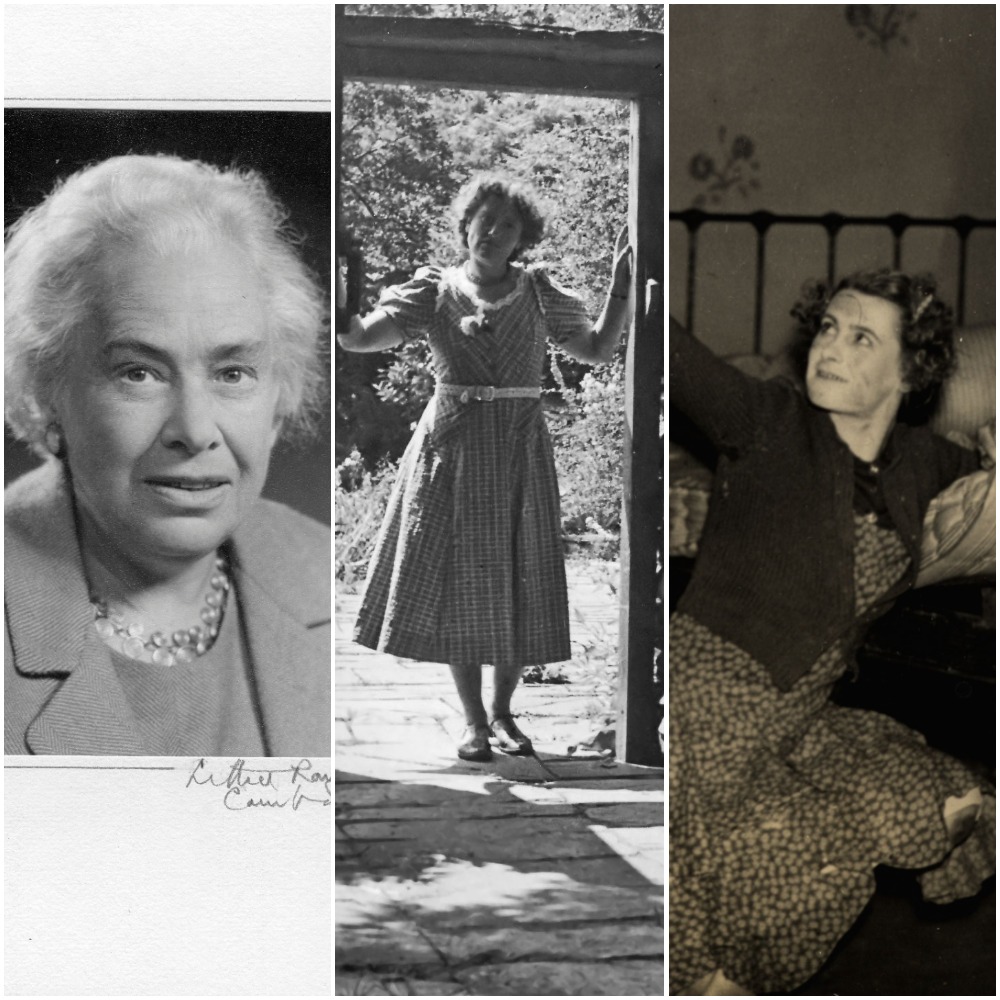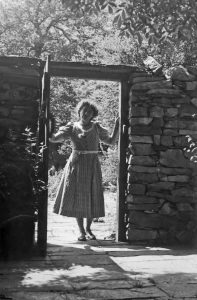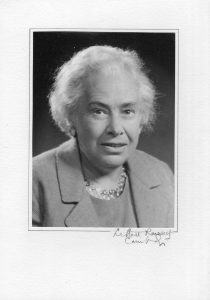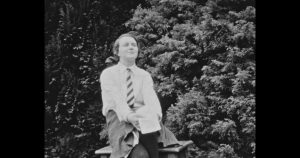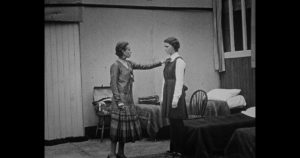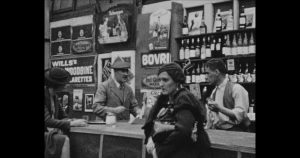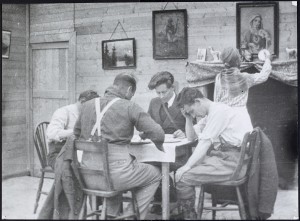Indigenous Irish cinema of the silent period (1916-1935) consisted of two waves, 1916-1926 and 1930-1935. Each wave drew filmmakers from both the theatrical and private sectors, with Irish theatre shaping cinematic content and style. The Abbey Theatre artists contributed to the theatrical, highly-charged nationalist films of the first wave, while the Gate Theatre artists strove to experiment in both style and content in the second wave. Formed by Micheál MácLiammóir and Hilton Edwards as an alternative to the Abbey in 1929, the Gate focused on more “modern and progressive plays unfettered by theatrical convention,” according to writer and theatregoer Joseph Holloway (39). This artistic vision carried over into Ireland’s last two silent films of the 1930s, Some Say Chance (1934) and Guests of the Nation (1935), both of which showcased the work of women pioneers. Siblings Frances Baker Farrell and Lettice Ramsey designed the indoor sets and scouted outdoor locations for Some Say Chance, which featured Gate actor Máirín Hayes in a small role. Baker Farrell’s husband, Irish novelist Michael Farrell, wrote, directed, and produced Some Say Chance and served as a cameraman on Guests of the Nation. Hayes edited the latter film with director and Gate playwright Denis Johnston. According to scholars, these three women worked on films that offered a contemporary, more realistic, and less nationalist image of Ireland than the pre-1930 films.
Baker Farrell and Ramsey were not theatrical artists, but their interest in filmmaking is not surprising as the sisters grew up in an artistic household. Though born in England, part of their childhood was spent in Ireland, first on an oyster farm outside of Sligo leased by their parents. As noted in the 1985 obituary “Mrs. Lettice Ramsey” in The Times, their mother, Frances, was a photographer and a painter who trained at the Slade School of Fine Arts in London and exhibited her work throughout Great Britain and Ireland (12). When their father died, their mother moved the family to the village of Ballysadare, Co. Sligo where she supported her daughters by selling her artwork. Her artistic interests made an impression on the sisters. According to Martin Lynch in “Michael Farrell Carlowman (1899-1962),” Baker Farrell became a weaver, working with her mother in the family weaving mill and workshop, The Crock of Gold, in Blackrock, Dublin (46). In 1926, she married Peter Trench, then divorced him and married Farrell in 1930. Ramsey read philosophy at the University of Cambridge where she met and married mathematician/philosopher Frank Ramsey who tragically died from liver disease in 1930. She took up photography as a profession, also working with pottery and collages. In 1932, she opened a studio in Cambridge with Helen Muspratt specializing in portrait photography of literary, intellectual, and social figures. Among their clients were Vanessa Bell, Virginia Woolf, C.P. Snow, and Guy Burgess (“Mrs. Lettice Ramsey” 12). When Farrell decided to try his hand at filmmaking, the sisters jumped at the chance to be part of this new creative venture.
Some Say Chance, completed in only five months according to J.A.P. in the 1934 Irish Independent, tells the story of Helen, a troubled young woman in a Wicklow boarding school who agonizes over her broken family (5). When she was younger, her father abandoned her and her mother, Irish Moll. Her father leads her to believe her mother is dead. Irish Moll, who turned to prostitution after her husband left, longs to reunite with her daughter. The film cuts between Helen’s days in an oppressive boarding school and her mother’s dangerous lifestyle in London. Scholars agree that in both subject matter and form Some Say Chance marked a new kind of cinema, one that told stories of the present, abandoning the literary forms of the past, particularly the romantic comedies/dramas and historical melodramas. As Ruth Barton notes in the 2004 Irish National Cinema, the earlier films were “regressive discourses,” focusing on stereotypes of Irishness and a history of injustices particularly at the hands of the British (25, 33). Some Say Chance, however, stood out not only in contrast to these earlier films, but also to other films of the 1930s. According to Kevin Rockett, “With the notable exception of Michael Farrell’s Some Say Chance (1934), a story linked to the moral decay of a city…film-makers in the 1930s turned their back on an exploration of contemporary Ireland” (1988, 59). The film’s focus on the subject of broken families and prostitution was groundbreaking.
The sisters’ set design reflects the narrative’s dark tone. Constructed and on-location sets contribute to Helen’s unsettling boarding school experience and her mother’s dangerous lifestyle. The open, lush Wicklow countryside contrasts sharply with the restrictive boarding school as teachers are both physically and emotionally abusive. Indoor scenes include a basic, almost antiseptic classroom, principal’s office, and dormitory. Working on a budget, the sisters used bed sheets for the walls in the dormitory. For the mother’s working girl scenes, they chose London streets at dusk and gritty indoor sets that portray the seedier side of the city’s nightlife. And Irish Moll’s barren bedsit reinforces her loneliness. Filmmaker Dean Kavanagh, who later rebuilt the film from rushes and edits, finds the sets “the most stand-out element…I have a particular fondness for the sequence where Irish Moll sits alone, in a state of despair, drinking in her abode and the walls are billowing. And of course that Epstein-esque moment when she dies and the wind flutters through the curtains” (2018, n.p.).
Dublin papers covered both the filming and initial screening, emphasizing the “Irish” production and the sets, but never crediting the sisters. “New Irish Film” in the Evening Herald proudly notes that Irishmen were working on a film in Ireland and London (5). And “This Weeks Examples” in the Irish Times indicates the filming “is going very well” (6). The film had a private showing on December 16, 1934, according to “Irish Amateur Film” in the Irish Independent (8). Reviews were generally positive, praising the effort, while noting the amateur quality. The Irish Press titles their coverage “Promising Film Made By Amateur” (8). According to J.A.P. in the Irish Independent, “the photography is very fine, indeed, and includes some unusually beautiful scenery” (5). And “Irish Amateur Film” applauds the sets and scenery, attributing the work, however, to the director even though the sisters received onscreen credit: “Not only has Mr. Farrell secured some very beautiful exteriors in Co. Wicklow and in Dublin, but he has been very successful in his London exteriors, particularly the glimpses of the moving illuminated signs” (8). The author also notes that the plot was “thin,” but this could be corrected with further edits prior to public exhibition. Reviewers in the Evening Herald and Irish Times assumed there would be future screenings throughout the Republic and the United Kingdom (“New Irish Film” 5; “New Irish Film” 4). A study of Irish and British newspapers, however, reveals no further screenings–until recently.
The story of the film’s rediscovery, archiving, and rebuilding began in the late 1940s when Farrell found fragments of the film in an outhouse. In a 1948 letter to a Miss Gibson at the Switzer’s Circulating Library in Dublin, he asks if she knows someone who can treat the film for screening. There is no evidence, however, that he ever sent the film to the Switzer or that a treated version screened. In an undated letter on RTÉ letterhead to film historian Liam Ó Laoghaire (O’Leary), documentary filmmaker Colm Ó Laoghaire explains that Baker Farrell deposited several cans of rushes and edited material of the film with him after her husband’s death in 1962. Colm indicates that the film is 1½ hours long and that he is trying to piece it together. He also informs Liam of a suitable extract for a program. Colm eventually deposited the cans with the Irish Film Archive. In 2015, the archive asked Kavanagh to rebuild the film using the existing footage. As he explains in his website post, “Though unfortunately not a restoration project (hopefully the missing elements of the film will be discovered one day) the film now stands as a new experience gleaned from surviving elements of the original plot, with scenes expanded and shaped using rushes and additional material. I was given the freedom to create a new cut, concentrating on the surviving narrative elements” (2016, n.p.). Kavanagh believes he kept true to the filmmaker’s intent by focusing on “coherent/character-driven shots,” though he admits that the ending was a challenge due to missing footage (2018, n.p.). The original ending, involving the death of the mother and her pimp and the reuniting of father and daughter, has been lost. In its place, Kavanagh closes with a letter indicating the father’s intent to return and scenes of Helen and other young women in the Wicklow countryside. Kavanagh’s thirty-seven minute film premiered at the Barbican in London on November 24, 2016 and later screened at the Carlow Arts Festival on June 9, 2017.
Local newspapers did not review these screenings, though previews briefly discuss the rebuilding, and one online silent film resource offers a review. None of these sources address the sisters’ set designs. Instead, they focus on the “screen debut” of Maureen O’Hara, then FitzSimons. O’Hara was an extra in the film, one of the school children recruited from the Abbey and Gate. Her three other sisters–Margot, Peggy, and Florrie–also filled the roles of school children, and her mother, Rita, a local actor and contralto, played Irish Moll. O’Hara was fourteen years old at the time and had just started training at the Abbey, according to the 2004 ‘Tis Herself: An Autobiography. However, her discussion of her early film career makes no mention of Some Say Chance, perhaps because the role did not include a speaking part (8, 18-22). The Times’ headline for an article on the Carlow screening notes “Maureen O’Hara’s screen debut to be shown at film festival” (Sanz n.p.). Similarly, Frances Mulraney’s article title in the online IrishCentral reads “Maureen O’Hara’s screen debut to be aired in Ireland for the first time in 83 years” (n.p.). In a rare review, “Irish Film Institute 1916 Centenary Ciné-Concert featuring Some Say Chance (1934),” a writer for Silentfilmcalendar.org discusses the Barbican screening, including a summary of the film and a brief history of Kavanagh’s work, before noting that the film is unremarkable except for the fact that Farrell would later serve as a cameraman on the “much better and better-known melodrama Guests of the Nation” (n.p.). The film’s original production, including the sisters’ contribution, even now remains unexplored.
The sisters left the film industry as quickly as they entered. Baker Farrell continued managing The Crock of Gold with her mother, taking it over after her death, according to “Ireland’s Industrial Advance” in the 1957 Gaelic Echo Agricultural and Industrial Review. The article also notes that she had reached international acclaim as a weaver, becoming “so famous for fine weaving that the Swiss hung her work in their galleries, brought her to Zurich to demonstrate her techniques there and appointed her chief instructor at the Cours Institute” (8). Ramsey continued her work as a photographer. When Muspratt left in 1937 to set up their studio in Oxford, Ramsey remained with the Cambridge studio until her retirement in 1978 (“Mrs. Lettice Ramsey” 12). Both Baker Farrell and Ramsey continued in the pursuit of these arts until their deaths, leaving behind a film that scholars acknowledge not just changed the direction of Irish cinema, but also stood out amongst the majority of 1930s films for its honest portrayal of contemporary Irish life.
***
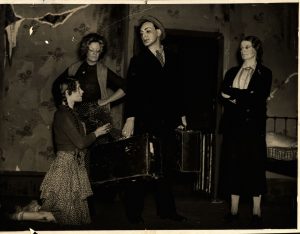
Photo of Máirín Hayes in the 1939 production of “Marrowbone Lane” at Gate Theatre, Dublin Evening Mail. Courtesy of Northwestern University.
Máirín Hayes, unlike Baker Farrell and Ramsey, came straight from the Dublin theatre scene. Hayes was born in New York City in 1914 to Irish parents who were living there. At the age of seven, Hayes secured her first acting job, according to Maeve in the 1934 Dublin Evening Mail, “when she played a boy in ‘Dregs’ by Mrs. Havelock Ellis, in America” (5). When her parents returned to Ireland, Hayes began acting in Dublin theatre, notably with the Dublin Repertory Players. She eventually settled at the Gate where she initially played children’s parts. In his 1947 theatrical autobiography, All for Hecuba, MácLiammóir remembers her “as a baby in these days; she wore two plaits and played children’s parts with ease and confidence. Now she is a very grown-up person and the plaits have disappeared, but I still see them there swinging at her back with all the jaunty conviction of fifteen years” (111). In addition to acting, Hayes served as an assistant stage manager at the Gate, working on seventeen plays, including film pioneer Mary Manning’s “Storm Over Wicklow” (1933), according to the Irish Theatre Institute’s online database PLAYOGRAPHYIreland. As the Gate broadened its creative scope, Hayes found herself caught up in the theatrical world’s commitment to the burgeoning film industry.
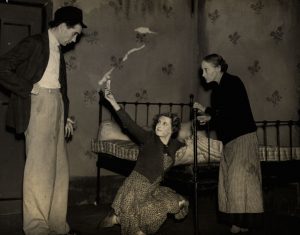
Photo of Máirín Hayes in the 1939 production of “Marrowbone Lane” at Gate Theatre, Irish Press. Courtesy of Northwestern University.
Both the Gate and Abbey theatres were determined to make indigenous cinema a vital part of the period’s cultural renaissance. Prior to 1930, theatrical artists, predominantly from the Abbey, launched the industry with romantic comedies/dramas and melodramas, some historical, and all focused on Irish history and culture. Abbey directors, actors, and writers worked for the prolific Film Company of Ireland, founded by Ellen O’Mara Sullivan and her husband James, as well as its successor Irish Photo-Plays. According to Barton, this was a cinema of heroic nationalism, focusing on Ireland’s struggle to be culturally and politically free of Britain (23, 27). The last film of this first wave, Irish Destiny (1926), chronicles the events surrounding the 1919-1921 War of Independence from the perspective of the rebelling Irish. After a four-year hiatus, the industry, spearheaded by the newly formed Gate, produced another kind of cinema, one that broadened the imagined national community and experimented with both cinematic and theatrical styles. Christopher Fitz-Simon notes in The Irish Theatre (1983) that “The Gate started as a reaction against ingrown nationalism, and emerged as a vital part of the national heritage” (181). Addressing the theatre’s formation, MácLiammóir explains in Theatre in Ireland (1963) that he and Edwards were dissatisfied with the Abby’s narrow interpretation of “national life” (24-25). They also wanted a theatre that experimented with all aspects of production, particularly lighting and design: “We secretly hoped, and indeed are still hoping, that through our experiments…we would at last discover a way more evocative than literal, more suggestive than photographic, that might serve as a mould for the Irish dramatist of the future…” (28). Six silent films were made in the 1930s, all of which reflected this artistic shift: the non-fiction shorts Bank Holiday (1930), Screening in the Rain (1930), and Pathetic Gazette (1930), along with three feature-length films, By Accident (1930), Some Say Chance, and Guests of the Nation.
Though Hayes only had a small part in Some Say Chance, in her work as co-editor of Guests of the Nation she touched a corner of the Irish industry that had eluded women. According to director Johnston’s journals, titled “3rd Omnibus X Book,” he invited Hayes to join him in editing the film. Shooting began in the spring of 1933, and editing commenced a year later in July 1934 (MS 10066 181/94/193; 181/101/207; 166/110/307). In his only reference to methodology, Johnston explains that he planned the shots with editing in mind (26/1-3). This suggests that either he and Hayes shared creative input or Hayes was employed only as a technician. However, when the film opened on January 20, 1935 at the Gate, Hayes received sole editing credit, suggesting that her contribution went beyond the technical.
The film’s editing works alongside Manning’s adaptation in telling the story of British and Irish prisoners during the War of Independence. Like the short story by Frank O’Connor on which it is based, the film fails to take sides in the conflict. Parallel editing sequences alternate between Irish prisoners in a British jail cell and British prisoners guarded by Irish rebels in an old woman’s home. Newsreels and a damaged Irish countryside are edited into the dramatic scenes emphasizing the toll the war is taking on both sides. Anchoring the narrative is the growing bond between the Irish captors and British prisoners as they joke, play, and help with chores around the cottage. The editing, like the script, elicits audience sympathy for “the boys” and the old woman who separates herself from the conflict. However, while the O’Connor short story privileges one of the Irish soldiers through his narration of the growing relationship with the British prisoners, Manning’s script and the Hayes/Johnston editing situate the old woman at the center of the evolving human drama. Through the placement of close ups and reverse shots in the sequences, the editing emphasizes the old woman’s shock and helplessness as she slowly realizes the British prisoners will be executed in retaliation for the death of their Irish counterparts.
Scholars agree that the film stands out in its avoidance of the pre-1930 preoccupation with heroic nationalism, some even acknowledging Hayes’ input as editor. In The Cinema and Ireland (1988), Anthony Slide mentions both Hayes and Manning, noting the unfolding human drama that expresses “the helplessness of the two IRA men ordered to murder two British soldiers in revenge for the execution of two IRA men held by the British” (19). Barton, myself, and Rockett all address the outright defiance of a national discourse. Barton regards Guests of the Nation as “The sole film of the period to question the prevailing orthodoxies of heroic nationalism…” by focusing on the “loss of human values in war” (46). In a 2013 article, I note Hayes’ editing and argue that the stereotypical “Irish mother,” obvious in the earlier Irish Destiny, is absent: “The Irish mother holds no symbolic value here. She has given no sons to the nationalist cause, nor is she able to care for other mothers’ sons” (Casella 67). Rockett sees Guests of the Nation as the first indigenous film that avoided a romanticized version of the conflict: “Little indication is given as to why the people were fighting, merely that they were pawns in a system outside their control” (61). Rockett also notes the effectiveness of the editing. Speaking of the ambush scene, he writes: “In addition, the tempo of the editing, in particular at the ambush, contrasts with the slow pace of the story. In fact this section is clearly influenced by Eisenstein’s montage: extreme close-ups of ‘typed’ faces intercut in rapid succession provides a strong sense of IRA camaraderie, unity and determination” (61). He makes no mention of Hayes’ contribution.
Hayes’ work as co-editor, however, resulted in a film that scholars continue to study, and exhibitors continue to screen. Johnston’s journals note public and private screenings throughout Great Britain and Ireland from its premiere through the 1980s (167/57/114; 301/534; 290/470; 290/3425; 301/531). A semi-private screening was held at the Irish Film Institute in 1990 for Manning and her brother, cameraman John, according to a 1990 press release “Guests of the Archive” (n.p.). And Sunniva O’Flynn, head of Irish Film Programming at the IFI, reports that in the last fifteen years the film has screened in Ireland, Italy, Czech Republic, England, and the United States (n.p.). It is not known whether Hayes was present at or knew about these screenings before her death. After the opening, she returned full time to the Gate. A study of Irish and British newspapers reveals Hayes was active with the Gate in Dublin and in their touring company abroad through the 1940s.
Hayes, Baker Farrell, and Ramsey contributed to the varied cinematic stories of this early period. Both Guests of the Nation and Some Say Chance were significant in that they broke with a tradition of Irish filmmaking that until the 1930s had emphasized pro-republican nationalist images. Some Say Chance avoided such nationalism by exploring Irish life untouched by either the War of Independence or the Civil War, and Guests of the Nation refused to take sides in the struggle for independence. However, both films were made with limited resources and, by the mid-1930s, there was little support for indigenous filmmaking in Ireland. Women pioneers like Hayes, Ramsey, and Baker Farrell returned to the theatrical arts or to other pursuits, their voices remaining silent until the 1980s when Irish women once again began to shape cinema in Ireland. The work of these early pioneers as well as that intervening “silence” bears further study.
See also: Mary Manning, Ellen O’Mara Sullivan

